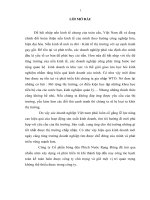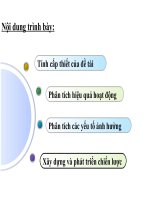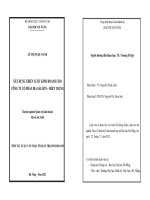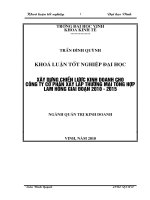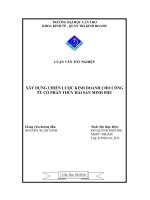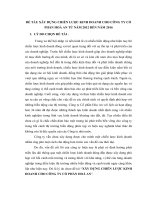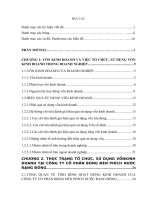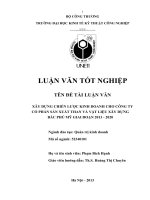Xây dựng chiến lược kinh doanh cho công ty cổ phần bóng đèn phích nước Rạng Đông
Bạn đang xem bản rút gọn của tài liệu. Xem và tải ngay bản đầy đủ của tài liệu tại đây (1.35 MB, 96 trang )
LUẬN VĂN
XÂY DỰNG CHIẾN LƯỢC KINH DOANH CHO CÔNG TY CỔ
PHẦN PHÍCH NƯỚC RẠNG ĐỘNG
BUILDING BUSINESS STRATEGIES FOR RANG DONG LIGHT SOURCE
AND VACUUM FLASK JOIN STOCK COMPANY IN THE PERIOD OF
2010 – 2015
- PAGE 1 -
INTRODUCTION
In the competitive world today, the existence and development of enterprises
depend greatly on the ability of continuous innovation and adaptation with the
changes of environment. In order to do that, companies need to clearly identify their
abilities, purposes, achievements, challenges... Those firstly depend on their setup
and implementation of enterprises’ business strategies. Proper business strategies
will ensure the existence, rapid development, long-term sustainability according to
the long-term goals.
There has been a lot of research on business strategy and method of business
strategy. Many researchers used quantitative and qualitative approaches in their
works. Each approach has its own advantages and disadvantages. Optimal solution
is to apply these two approaches in building business strategies for enterprises to
maximize advantages and minimize disadvantages.
Within the research of this great exercise, two selected matrices are:
Strengths-Weaknesses-Opportunities-Threats Matrix (SWOT Matrix) and Internal –
External Matrix (IE Matrix), which is representative for qualitative and quantitative
methods of analysis. Research methods will be applied to a specific case: Building
business strategies for Rang Dong Light Source and Vacuum Flask Join Stock
Company in the period of 2010 – 2015.
Rang Dong Light Source and Vacuum Flask Join Stock Company (Rang
Dong Company) was established in February 1961, which was originally as Rang
Dong Light Source and Vacuum Flask Factory. In June 1994, it was renamed as
Rang Dong Light Source and Vacuum Flask Company. On 30 March 2004,
Ministry of Industry (now Ministry of Industry and Commerce) decided to switch
the Rang Dong Light Source and Vacuum Flask Company to Rang Dong Light
Source and Vacuum Flask Join Stock Company.
Vietnam’s process of integration into the world economy not only affected
on the macroeconomic environment but also directly on production of individual
- PAGE 2 -
business enterprises. For Rang Dong Company, integration created not only
opportunities but also great challenges which required the company to define proper
and well planned business strategies in the future. However, the process of setting
up business strategies was not properly interested. Therefore, a research on selecting
setting up approach is unprejudiced and necessary.
Research purposes
Firstly, systemization of basic knowledge on business strategies and business
strategy approaches.
Second, research on the ability, approach and conditions to apply SWOT
Matrix and IE Matrix; the coordination of both matrices to formalize and select
business strategies for enterprises.
Third, application of research results on building the business strategies for
Rang Dong Light Source and Vacuum Flask Join Stock Company in the period of
2010 – 2015.
Research Objectives
Research objectives are SWOT Matrix and IE Matrix. Scope of research is
the ability, approach and conditions to apply both matrices in building business
strategies for enterprises in general and for Rang Dong Light Source and Vacuum
Flask Join Stock Company in particular.
Research methods
Thesis using the method of the research combination of logic and history,
general analysis methods, the scientific statistics method.
Thesis based on the theory contruct of business strategies in the market
mechanism, combined analysis of synthesis of empirical research.
Research result to dates
Until now, there are many researches on business strategies and method of
building business strategies, SWOT Matrix and IE Matrix specifically. However,
those researches only used either qualitative or quantitative approach. Contribution
of this exercise is the ability, approach and conditions to apply both tools.
- PAGE 3 -
In Rang Dong Company, there are not research on business strategies and
method of building business strategies. The activity of business strategies, which is
implemented by Accounting - Finance Department, is not the scientific and
professional.
Therefore the exercise of “Application SWOT Matrix and IE Matrix
analysis model on building business strategies for Rang Dong Light Source and
Vacuum Flask Join Stock Company in the period 2010 – 2015” is necessary and
valuable in practical constraints.
Structure of the exercise
Besides the introduction, conclusion, table of contents and reference
materials, the exercise is divided into three main sections:
Chapter I: SWOT Matrix and IE Matrix Model – An effective instrument in
building business strategies.
Chapter II: Application of SWOT matrix and IE matrix models in analyzing
business strategies.
Chapter III: Application of SWOT matrix and IE matrix models in
formation and selection of business strategies for Rang Dong Light Source and
Vacuum Flask Joint Stock Company in the period of 2010 - 2015.
- PAGE 4 -
Chapter I
SWOT MATRIX AND IE MATRIX MODEL - AN EFFECTIVE
INSTRUMENT IN BUILDING BUSINESS STRATEGIES.
1.1.
BUSINESS
STRATEGIES
AND
BUSINESS
STRATEGIES
PROCEDURES.
1.1.1. Business strategy
1.1.1.1. Business strategy viewpoint
"Strategy" which is a term used in military, that is intrigues conducting the
war. It is based on the military, political, economic, geographical conditions of the
two opposing forces and war situations to prepared and to use military force.
There are many views on business strategy:
Strategy is the ways to achieve long-term goals. Business strategy can be a
strategic geographical expansion, diversification of products, mergers, product
development, and market penetration, reduce or waive take-over or joint venture.
Strategy is a collection of goals and policies as well as essential plans to
achieve those goals. Business strategy of an enterprise is an action plan to
implement goals of the enterprise.
Business strategy is intriguing strategy, roads, measures to ensure stable and
long-term existence, development in accordance with development goals that
enterprises have set based on the objective and subjective conditions, the resources
of business.
So there are lots of opinions about business strategy, but it could be the most
common point of business strategy as follows: Business strategy is the collection
of long-term goals and the ways to achieve long-term goal that is based on
objective and subjective conditions, and the resources of the business. Business
strategy is determined for a certain period; it is the orientation and can be adjusted
to changes of the environment.
Based on the scope, business strategies are divided into two types: general
strategy (or overall strategy) and partial strategy.
- PAGE 5 -
Based on building-level strategies, business strategies are divided into:
strategy of enterprise, strategy of base unit (SBU) and functional strategy.
Based on the content and the field of governance, business strategies are
divided in accordance with management fields in enterprises.
Based on the nature and scope of work, business strategies are divided into
four types: combination strategy, specialization strategy, expansion strategy and
specific business strategy (narrow, link ...).
1.1.1.2. Business strategy requirements
Business strategy of an enterprise should ensure the following requirements:
Firstly, business strategy has to ensure the generalization. Business strategy
is an overall plan of the enterprise; it decides the relationship of the enterprise with
the outside environment. Generalization is shown as followed: (i) in accordance
with conditions, development trends of the enterprise; (ii) in accordance with
national conditions, development trends of the country in a certain period; (iii) in
accordance with integration trends into international economy. A strategy with
generalization is important to ensure the judicious and sustainable development of
the enterprise.
Secondly, business strategy has to ensure the orientation. This is important,
it ensures enterprises have a right direction in the long term, and avoids pursuiting
inefficient movement. To have good business strategies, it is necessary to have good
forecasting socio-economic development trends. Successful business strategy must
base on accurate forecast.
Thirdly, business strategy has to ensure the increase of internal forces to
gain competitive advantage for enterprises. If there are no competitors business
strategy does not need to be developed. Business strategy is really necessary when
there is competition in the market. The more severe the competition is, the more
important business strategy is. In order to create competitive advantages companies
need to thoroughly exploit their comparative advantages, invest resources to utilize
the strengths rather than invest too many resources to overcome weaknesses.
- PAGE 6 -
Fourthly, a business strategy has to ensure the safety for enterprises.
Business activities always contain risky factors that enterprises must cope with.
However, higher profit rate usually connects with higher risk but the factor of safety
is very important for business. To achieve this requirement, a business strategy must
identify “safe scope”, at which the risk can still occur with lowest probability. Do
not build business strategies as the following idea "all or nothing".
Finally, it is necessary to determine the business scope, objectives, action
plan and the basic conditions to achieve objectives. In the present competition
context, the decisions of the enterprises are always limited by resources constraints.
Thus business strategy has to determine the scope of business in which the
enterprise must well define objectives of the business to avoid the spread of
resources. A well-defined business plan is a set of policies, measures and resources
- technology - labor conditions for the achievement of business objectives.
Requirements for the explanation of business plan are adequate, concise and clear.
1.1.1.3. The role of business strategy
It is difficult to find a direct relationship between business strategy and the
increase of profits. However, it cannot be denied indirect contribution to the benefit
of the business strategy through the exploitation of opportunities and competitive
advantages.
Firstly, business strategies help business leaders and individuals in the
enterprise understand the goals and direction of their enterprise. Through which
people know their position, role, responsibilities and their ability to contribute to
common goals. So through the enterprise achievement of common goals, each
member also achieves his goals. Besides, in business practices, the environment
changes also require enterprises to adjust it and to adapt to those changes. Business
strategy to help enterprises keep to their objectives.
Secondly, when building business strategies managers must make
predictions about the business environment in the future. Therefore business
- PAGE 7 -
strategies help business manager’s better capture and take advantage of
opportunities, reduce the risk that may occur in the future.
Thirdly, thanks to business strategy that the decisions of the enterprise are
completely active. Enterprises without clear business strategies often react passively
when the business environment changes. Sometimes this reaction also is effective
but building clear business strategies and change forecast help enterprises react
better with environment changes and take command of the situation.
1.1.2. Process of building business strategies for enterprises
In general there are many steps to build business strategies of enterprise.
Based on the ideas and research objective that researchers present different models
and steps.
The first viewpoint is Plan-Do-Check-Act Model (PDCA) by Shewart:
Table 1.1: PLAN-DO-CHECK-ACT MODEL BY SHEWART
Check
Act
Plan
SWOT Matrix (Strengths, Weaknesses, Opportunities, Threats)
Review the business environment.
Effective indicators
+ In the past
+ In the present
Customer needs and the beneficiaries
+ Inside.
+ Outside
Evaluation project data in 3 years.
Source of input.
Development/ Review /Check
Vision.
Value.
Duties.
General objective.
Specific objectives (annual).
Strategy.
Schedule.
Review Plan.
- PAGE 8 -
Do
Implementation of project
Check
Check and communicate
Monthly
Quarterly
Annually
Review or standardize
Based on the evaluation.
Act
Different point of view states that the building business strategy consists of
following 10 steps:
Diagram 1.1: BUILDING PROCEDURES OF 10-STEP STRATEGY
Analysis of objective conditions
Business
Orientation
and fields
Strategic
goals
Business
strategy
Analysis of subjective conditions
Strategic
thought
Implement
business strategy
Path design
and selection,
measures to
achieve goals
Strategies
of
functional
divisions
Assess and improve
business strategy
According to this point, the construction business strategy is 10 steps work,
dividing into three main steps: analysis of objective and subjective conditions of
enterprise; design of business strategy, assessment and improvement of business
strategy.
Also following 10-steps procedure, the following model start from the
review mission objectives and current strategies of the enterprise:
- PAGE 9 -
Diagram 1.2: COMPREHENSIVE STRATEGIES MANAGEMENT MODEL
Environment
research to
identify main
opportunities
and challenges
mainly
Review
mission
objectives
and
current
strategies
Set long
term
goals
Set short
term
goals
Distri
bute
of
resour
ces
Define
mission
Internal
analysis to
identify
strengths
and
weaknesses
Draw out
the
departme
nt policy
Choose
strategy to
proceed
Build
strategy
Measure
and
evaluate
the level of
implement
ation
Implement
strategy
Assess
strategy
There are many opinions about building business strategy of the enterprise;
departing points of each model are different. However, in general, the process of the
business strategy must include 7 basic steps as follows:
- PAGE 10 -
Diagram 1.3: PROCEDURE CONSTRUCTION BUSINESS STRATEGIES
Analysis of business
environment
Analysis of internal
environmental
Determine
the strategic goals
Form different business
strategy scenarios
Select
business strategy
Implement
business strategy
Assess and improve business
strategy
1.1.2.1. Business environment analysis
Business environment of enterprises can be divided into two levels: macro
environment (also called the national economic environment) and micro
environment (sectoral environment). When researching on business environment
and influence on activities of enterprises, it needs to know that, the environment
consists of factors, affecting enterprises in different ways and these factors also
interact and affect themselves, on the other hand, they continuously change and are
difficult to predict accurately.
Macro Environment
Factors under macroeconomic environment affect all business sectors but not
in the same way. Macroeconomic environment, including the following
- PAGE 11 -
environment: economic environment, political and legal environment, social
environment, technological environment, natural environment.
Economic environment includes the factors influencing greatly on
enterprises. Influencing factors include stages of economic cycles, interest rate
policies, fiscal and monetary policies, national income trends, inflation, tax policies,
and so on.
Political and legal environment has more and more influence on activities of
enterprises. The Government promulgates policies, regulations which require
businesses to comply with such as the tax laws, the laws on environmental
protection, the laws of international trade, law on advertisement... and ensures the
stability of politic and law.
Social environment includes complex factors, which change slowly and are
difficult to recognize. When analyzing the impact of social factors, people often pay
attention to the following factors: consumption trends, living standards, age, gender
- gender equality, career... and a number of population factors as speed growing
rate, change trends, population density...
Natural environment: for industry in general, people pay particular attention
to the impact of the manufacturing process of the enterprises to the environment.
Increasing treatment cost of wastewater, solid waste, gas is an important factor to
consider when deciding to invest.
Scientific and technological environment: Never has the science and
technology developed as fast as present. Modern technologies continuously create
and that makes enterprises force the risk of technological lag behind.
Micro environment
Micro-environment includes many factors that decide the nature and extent
of competition in the industry as current competitors, potential competitors,
consumer, suppliers and substitute products.
In competition, the first and most important problem that enterprises need to
consider is current competitors of the enterprise: (i) current competition strategies
- PAGE 12 -
of the competitors, (ii) their future objectives, (iii) the potentials of the competitors
on production, research, distribution, finance, human resources... Research results
on competitors of an enterprise must answer four questions: Are competitors
satisfied with their current position? How do they adjust and change their
strategies? What are their strengths and weaknesses?
Enterprises must also pay attention to potential competitors which can join
the industry. Sectoral enterprises should take advantage of legal fences to protect
themselves. They are the economic scale, advantages of price, ability to diversify
products, sectoral entering costs, difficulties in the penetration of consumption
channel, legal ability to resist and prevent of sectoral enterprises...
Customers are people who decide viable opportunities and development of
an enterprise. Consumer’s power depends on: (i) proportion of the volume of
purchasable goods in volume of selling goods, (ii) costs and the ability to change
the new provider, (iii) customer’s ability to incorporate back (with suppliers), (iv)
impact of the monopoly and quality of selling product on consumer’s product
quality...
Impact of suppliers to the enterprise is contrary to the customers. In
relationship with this counterpart, the enterprise’s impact-bearing ability depends on
the position of the enterprise in comparison with others and position of the business
for suppliers.
An important factor affecting the nature and extent of competitive pressure is
the substitute products. The enterprises pay attention to not only present substitute
products but also potential substitute products. Most of the substitute products are
the result of technological explosion, so focus and investment of an important part
of resources in technology is strategically investment.
1.1.2.2. Internal environmental analysis
When building business strategies, enterprises need to carefully analyze the
internal environment to know the strengths and their weaknesses. Factors which are
- PAGE 13 -
focused in internal analysis are: human resources, manufacturing and research, field
marketing, finance, economic linkage and cooperation...
Production and research abilities, which include two independent aspects but
have close relationship, are production and research and development (R & D). To
assess production capacity, it is necessary to consider: production ability of main
products, productive equipment and technology, organization and operation of the
manufacturing process, the quality management system, products structure, life
cycle and the competitiveness of each product ... To assess the capacity of research
it is necessary to pay attention to the ability to develop new products.
Labor is the factor which plays an important role and is a valuable asset of
the enterprise. Evaluating the human resources of the enterprise which are divided
into the administrators and direct workers bases on different evaluation criteria. In
particular, assessment of administrators needs to pay attention to skill management,
skills management, working style, ethics. For direct workers, the most important
aspects are working skills, qualification and discipline.
Assessment of financial capacity must base on three main criteria: payment
ability, rate of capital turnover and profitable ability. Payment ability shows the
capacity of payment of critical debts; the rate of capital turnover expresses business
capacity and business management; profitable ability shows the effectiveness of
business investment activities.
Rating marketing capacity should pay attention to: the marketing activities
and marketing activities evaluation, brand motivation activities, building and
managing distribution channels, trade promotion activities... Distribution channels
organization and maintenance should be specially focused.
Economic linkage and cooperation show the sensitive ability to capture
market needs choose business partners to minimize the weaknesses and to utilize
strengths.
- PAGE 14 -
1.1.2.3. Identify of strategic goals
Strategic goals of the enterprise is the results that the enterprise must achieve
in a period of time in accordance with objective and subjective conditions, and the
enterprise’s ability toward defined plan.
A good strategic goal need to meet "SMART" standards as follows: Firstly,
the goal must be specific (Specific); secondly the goal is measurable (Measurable)
through a set of indicators; thirdly goal must be feasible (Achievable), which an
enterprise can be achieved on the basis of current capacity, fourthly the goal can be
able to be assessed and reviewed (Reviewed) and finally the goal must be defined in
a certain period of time and have a deadline to complete (Time controlled).
In different phase, different enterprises will define a different set of targets.
However, it may be divided into two main groups as follows: financial targets
(revenue, profits, stock prices ...) and non-financial targets (brand, market share,
business development, product structure, new products ...).
Defining goals of the business requires discussion among different
management levels, the department managers and employees in enterprises.
Enterprise’s goals need to be classified in priority orders to follow from general
objectives of the enterprise to specific objectives of each level, each department.
1.1.2.4. Business strategy analysis
Next step is to use available information, based on strategic goals of the
enterprise, to analyze and build business strategies.
As analyzed above, the analysis of business environment and internal
business environment provides necessary information to build business strategies.
Based on this information, enterprises choose the business direction and scope,
business product, the market, the engineering field.
After analyzing the business environment and internal business environment
enterprises need to set out a number of business plans to achieve strategic business
direction and objectives. They should base on the results of the analysis and their
differences must be clear.
- PAGE 15 -
There are many applicable forms and methods in the formation of the
strategies in this period. The use of selection models which consider data collection,
data connection and information analysis, the final product is a strategy to pursue.
Models such as SWOT, SPACE, BCG, IE, competitive positioning Matrix CP, and
GE ... should be used for more accurate quantitative assessment.
1.1.2.5. Business strategy selection
Once business plans have been developed it is necessary to conduct analysis
and assessment of these plans to select an optimal plan. Each plan has its
advantages and disadvantages.
There are many approaches to evaluate strategic plans. It is necessary to
identify standards in assessing plans. Different criteria for evaluating plans could
lead to different selection.
The standards must consider different aspects, and help managers select a
business plan which meets the following conditions: environmental conditions and
circumstances, cycle life of products and market potentials, overall and long-term
interests of the enterprise, utilization of enterprise’s production potentials and
power; enterprise’s financial, facility and labor ability, in accordance with the
internal policies, business philosophy, management style of the enterprise…
1.2. SWOT MATRIX AND IE MATRIX MODEL
1.2.1. SWOT Matrix
1.2.1.1 SWOT Matrix Description
Strengths - Weaknesses, Opportunity - Threats Matrix (SWOT Matrix) is a
tool to develop strategies which combines internal strengths and weaknesses of the
enterprise with opportunities and risks from the environment. SWOT analysis is key
to develop strategies.
SWOT model enables analysis of different factors relatively influence
competitiveness of an enterprise. SWOT analysis evaluates SWOT data in a logical
order to help readers understand as well as present, discuss the decision easier.
- PAGE 16 -
Table 1.2: SWOT MATRIX
(Always leave blank)
O: The opportunity
(List)
T: The threats
(List)
S: The Strengths
(List)
SO: Strategies
(List)
ST: Strategies
(List)
W: The weaknesses
(List)
WO: Strategies
(List)
WT: Strategies
(List)
SWOT Matrix includes 9 cells of which 4 cells are used to the list strengths weaknesses - opportunities - threats factors, and the other 4 cells to list formed
strategies, top-left cell leaves blank.
1.2.1.2. SWOT Matrix Contents
To analyze SWOT for an enterprise, it is necessary to analyze the
environment, collect information and answer the following questions:
Strengths: What are the advantages of the enterprise? Which activities does
the enterprise implement the best? Which resources does the enterprise have the
best advantage? It needs to consider issues on aspects of enterprise itself and others,
and to practically and objectively evaluate them.
Weaknesses: What are main weaknesses? Which weaknesses can be
improved? What does the enterprise need to avoid? Why can competitors do better?
It needs to play attention to market information, which weaknesses that competitors
can see but the enterprise cannot.
Opportunities: What are the best opportunities? Which trend is the market
concerned of? The most useful search method is to review the strengths of the
enterprise itself and ask the question whether these advantages can bring in new
opportunities. To the contrary, it is necessary to review the weaknesses and ask
questions whether there is any opportunity when eliminating these weaknesses.
Threats: Which obstacle does the enterprise cope with? What are
competitors doing? Do specific requirements of product, service change? What are
the risks of technology change to the enterprise?
- PAGE 17 -
SWOT Matrix is an important combination tool which can help managers
develop four following strategies: strengths - opportunity strategy (SO), weaknesses
- opportunities strategy (WO), strengths - threats strategy (ST) and weaknesses threats strategy (WT).
Combination of internal and external factors is a difficult task in the
development of a SWOT Matrix, it requires good judgments. Looking at the table
we will see four specific types of strategy as follows:
SO strategies use the strengths of the enterprise to take advantage of outside
opportunities. This is a perfect location. All managers expect their enterprise in this
position that the strengths can be utilized to meet the outside trends and
opportunities. When a business has great weaknesses, it will also try to overcome.
While facing the serious threats, it is important to find ways to shun and focus on
opportunities.
WO strategies improve internal weaknesses by making use of the external
opportunities. With regard to external opportunities, other enterprises with
weaknesses try to prevent the enterprise utilizing these opportunities
ST strategies promote the strengths of an enterprise to evade or to reduce the
negative impacts of the threats from the external environment.
WT strategies are defensive strategies to reduce internal weaknesses and
avoid the threats from the external environment. An enterprise in this position does
not often have good business results, because it has to overcome many internal
weaknesses while dealing with threats from the environment. In this case, the
enterprise must fight to survive, link or merger to avoid bankruptcy.
1.2.1.3. SWOT Matrix Advantages - Disadvantages
Advantages
SWOT Matrix has the following advantages:
Data in SWOT order is very logical and easy to follow.
It analyses and considers all the factors affecting the business activities of
enterprises from business environment and internal environment;
- PAGE 18 -
It is a dimensional analysis with a group of strategic plans for enterprises to
assess and select;
Strategic plans are diversified, flexible. It is possible to choose a major
strategic plan in combination with other strategic plans to form a complete strategic
plan...
Disadvantages
However, SWOT Matrix also has some disadvantages as followed: it is
qualitative and difficult to combine with internal and external factors. It requires
good judgments and difficulty to decide the final plan...
1.2.2. IE Matrix
1.2.2.1. IE Matrix Description
Internal - External Matrix (IE Matrix) also called the investment analysis
matrix, because it analyses and marks enterprise’s departments in a chart. Circle
dimension shows percentage of sales of each department, and circle represents
percentage of the profits of each department.
Figure 1.1: IE MATRIX TABLE
Total
point
of
EFE
matrix
Total point of the IFE matrix
Strong
3-4
High 3-4
Average 2-2.99
Low 1-1.99
Construct and develop
Average
2 – 2.99
I
II
IV
Weak
1 – 1.99
III
V
VII
Hold and maintain
- PAGE 19 -
VI
VIII
IX
Harvest and remove
IE Matrix is based on two main aspects: the total points of IFE Matrix
(Internal Factor of Environment) on the X axis and the total points of EFE Matrix
(External Factor of Environment) on the axis Y. Theatrically, it is necessary to setup
IFE matrix and EFE matrix for each department of the enterprise through which the
image of each department can be seen in the IE matrix. However, in practice, people
often set up IFE matrix and EFE matrix at enterprise level to compare among
different enterprises.
EFE Matrix evaluates the response of an enterprise to the elements of
external environment. IFE Matrix assesses the internal strength of the enterprise.
All the boxes in the same column have the same total important points of an
IFE Matrix, including 3 levels of weak, medium and strong points, 1.00-1.99, 2.002.99 and 3.00-4.00 correspondingly.
Region I, II, IV: construction and development strategies should be applied.
Region III, V, VII: hold and maintain strategies should be applied
Region VI, VIII, IX: harvest and remove strategies should be applied.
1.2.2.2. IE Matrix Contents
IE Matrix is built from the results of IFE and EFE matrix, so building IE
matrix should start from the construction of IFE and EFE matrix.
EFE Matrix
External factors matrix allows managers to evaluate enterprises’ reaction
ability to the impact factors belonging to the business environment. Construction of
EFE Matrix includes six steps:
Step 1, Business environment analysis of enterprises, including all elements
of macro and micro environment which affect to the results of business strategy
implementation.
Step 2, Listing external factors which decide the success of enterprises as
identified in step 1. Minimum factors are 5, typically 10.
- PAGE 20 -
Step 3, specifying the ratios of this factor from 0.00 (not significant) to 1.00
(very important). These ratios show the importance of the corresponding factors to
the success of the enterprise. Total ratio of all these factors is always 1.
Step 4 setting points from 1 to 4 which represent reaction of the enterprise to
each key factor. 4 represents excellent reaction, 3 – good reaction, 2 - average
reaction and 1 - weak reaction.
Step 5, factor ratios are multiplied with their points to make convert points of
each factor.
Step 6, Convert points are summed to have the total important points of
enterprises.
Table 1.3: EFE MATRIX TABLE
Order
Main External Factors
1
The process of international
economic integration
2
Political
stability,
environment stability
3
Living standard, average income
4
Market Needs
5
Domestic
and
Competition
Ratio
Points
1-4
Convert
Points
business
International
…
Total
1
1-4
Total points important from 1.00 to 2.00, the average are 2.50.
Total points are 4: enterprises react very well with the opportunities and
challenges from the external environment.
Total points are 1: present strategy does not help enterprises take advantage
of the opportunities and limit the challenges from the environment; business
strategy needs to be adjusting.
- PAGE 21 -
IFE Matrix
IFE Matrix allows managers to assess internal strength of enterprises.
Table 1.4: IFE MATRIX TABLE
Order
Main Internal Factors
1
Organizational
operating capacity
2
Technology
capacity
3
Research
capacity
4
Human resources quality
5
Financial Capacity
6
Marketing capability
and
and
Ratio
Points
1-4
Convert
Points
structure,
production
development
…
Total
1
1-4
Like EFE Matrix, IFE Matrix construction should include 6 steps:
Step 1, analyzing the internal environment of enterprise.
Step 2, listing factors which are identified in step 1. Factors typically are 10,
5 at least.
Step 3, specify the ratio for each factor from 0.00 (not significant) to 1.00
(very important). Factors are reviewed their importance, even strengths or
weaknesses of the enterprise. Ratio is based on the comparison in the industry.
Step 4, determine the points from 1 to 4 for each factor: 1 is the major
weakness, 2 points and is minor weakness, 3 is small strength, and 4 points is a
great strength.
Step 5, factor ratios are multiplied with their points to make convert points of
each factor.
Step 6, Convert points are summed to have the total important points of
enterprises.
- PAGE 22 -
Lowest score is 1.00 and 4.00 is the highest, the average is 2.50. Points lower
than the 2:50 show that the enterprise has weak internal environment and higher
showed that the enterprise has strong internal environment.
1.2.3.3. IE Matrix Advantages - Disadvantages
Advantages
Contrary to SWOT matrix, IE Matrix is quatitative. From the analysis
results, it is possible to identify strategic plan because this matrix is divided into
three main regions…
Disadvantages
However, application of IE matrix is quite complex because two Matrices –
EFE Matrix and IFE Matrix - must be created and then General IE Matrix is
created. Besides, the number of strategic plans is few, and is not able to combine to
form the general plan...
Because of the advantages and disadvantages of each model, the application
of each model in building business strategies of enterprises will be limited and
difficult. On the other hand, the basis for building both these matrices is the result of
analyzing the business environment and internal environment of enterprise.
Therefore, while applying both SWOT Matrix and IE Matrix is necessary and
scientific.
1.3. APPLICATION OF SWOT MATRIX AND IE MATRIX IN BUILDING
BUSINESS STRATEGIES
Applying SWOT Matrix and IE Matrix in building business strategy of the
enterprise will be conducted in two phases:
Phase 1, using SWOT Matrix and IE Matrix and SWOT analysis of each IE
group elements under macroeconomic environment, the environment of micro
enterprises and capacity analysis of the business in its own governance. This results
in phase 2.
Phase 2, based on analysis results of phase 1, SWOT matrix and IE matrix
are created and analyzed at enterprise level. Results SWOT and IE analysis for each
- PAGE 23 -
group of factors and fields is the basis for evaluating of strengths - weaknesses,
opportunities - threats in SWOT matrix and factors marking in IE matrix.
1.3.1. Application of SWOT matrix and IE matrix in business environment
analysis
Macro and micro environment of enterprises include a variety of factors,
which directly and indirectly impact the existence and development of enterprises.
For each group of factors, after considering all involved aspects, the qualitative
analysis results of the will be reviewed in SWOT Matrix. Applying SWOT matrix
to analyze these factors will classify the opportunities (O) and threats (T) for the
enterprises.
These factors will also be analyzed in the external factors matrix EFE to
quantify response capabilities of the enterprises to the impact of external factors
from the outside environment.
1.3.2. Application of SWOT matrix and IE matrix in internal environment
analysis
To assess the internal strengths of an enterprise, it is necessary to conduct
analysis of all working fields to find out strengths and weaknesses of that enterprise.
SWOT Matrix is used to qualitatively evaluate and find out the strengths,
weaknesses. IFE Matrix is used to quantify these factors.
Thus, the SWOT matrix is used to assess the strengths (S) and weaknesses
(W) of the enterprise. IFE Matrix is used to analyze internal strength of the
enterprises to choose the right strategy.
1.3.3. Application of SWOT matrix and IE matrix in formation and selection of
business strategies
Using SWOT matrix and IE matrix to form business strategies of enterprises
after:
Creating SWOT Matrix (OT) to analyze the opportunities and threats for
enterprises toward the impact of factor from the business environment;
- PAGE 24 -
Creating EFE Matrix to evaluate response capabilities of enterprises in the
face of the change of each factor;
Creating SWOT Matrix (SW) to analyze the strengths and weaknesses of
enterprises in each field;
Creating IFE Matrix to assess the strength of enterprises in each field.
Based on the analysis results of these matrices, they are synthesized into the
SWOT Matrix, IFE and EFE Matrix for enterprises to form four groups of business
strategies. They are Strengths - Opportunities strategy, Weakness - Opportunities
strategy, Strengths - Threats strategy, and Weakness - Threats strategy.
Business strategy Selection based on four groups of strategies needs to
follow two steps:
Step 1, based on the location of enterprises in the IE Matrix, determine the
overall strategy that the enterprise should apply. Including one of three strategic
steps strategy: construct and develop, hold and maintain, harvest and remove. Then
identify the main strategy from four groups of strategies in SWOT Matrix.
Step 2, use the scoring method to evaluate the advantages - disadvantages of
each plan to select the best strategic plan for enterprises. There are many methods to
choose the final strategic plan, in which scoring method is commonly used.
This method has advantages which are quantitativeness, objective
assessment, and multi-dimension evaluation.
Selection business strategy by scoring method
Step 1, determine the criteria to evaluate business strategies, including
internal and external criteria, strengths and weaknesses of enterprises.
It is not necessary to select strengths or weakness, but to select the factors
that affect the performance of the enterprise. The criteria are determined very
quickly, easily from the results of SWOT and IE analysis.
Step 2, determine the ratios for each factor from 0.00 (not significant) to 1.00
(very important). The total ratio of all factors is 1.
- PAGE 25 -
